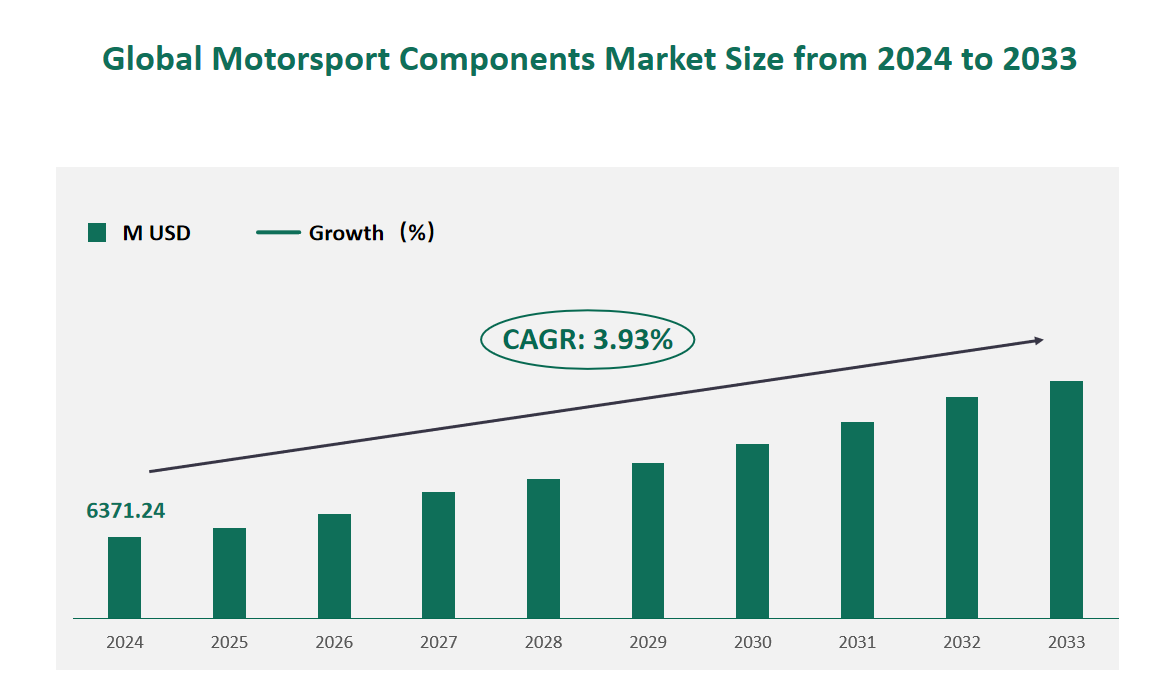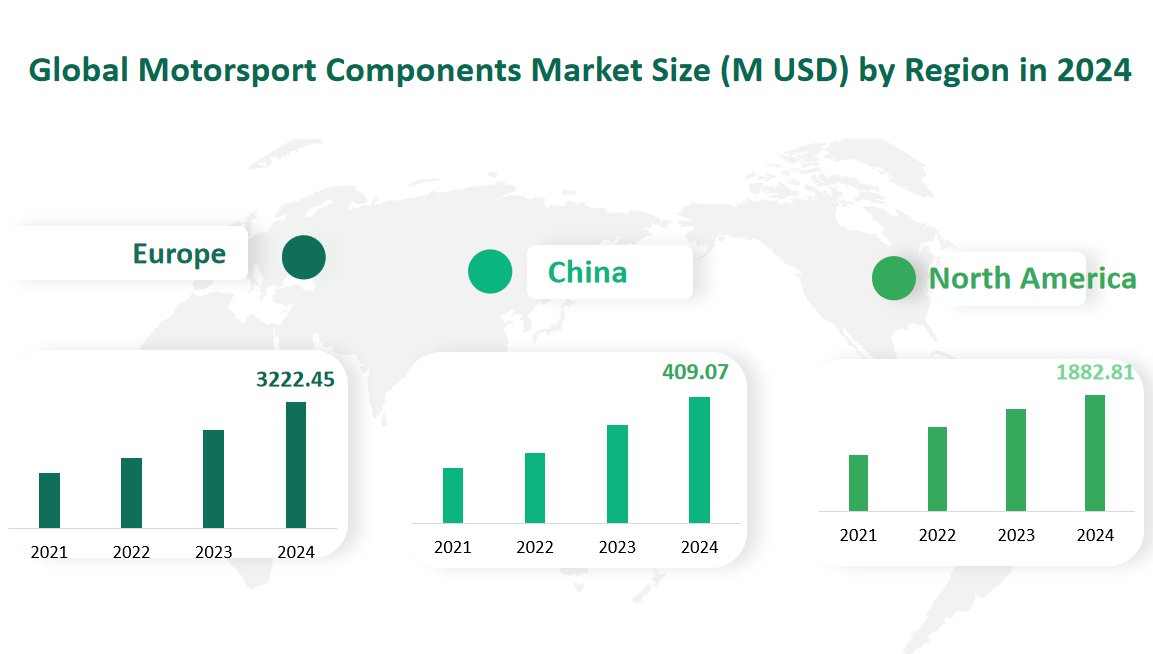1 Global Motorsport Components Market Size (Value) and CAGR (2024-2033)
In 2024, the global Motorsport Components market was valued at USD 6371.24 million, with a CAGR of 3.93% from 2024 to 2033.
A motorsports vehicle such as a motorcycle, a car, and a truck are used in a competitive sporting event. Mechanical failures and technological problems such as failures in the brake system, powertrain, electronics and other components must be replaced, increasing the market demand for motorsport components. The increasing number of motorsport vehicles is increasing the call for the motorsport components market.
Figure Global Motorsport Components Market Size (M USD) and CAGR 2024-2033

2 Motorsport Components Market Drivers
One of the primary drivers of the Motorsport Components market is the increasing demand for high-performance parts. Motorsports, by their nature, require vehicles to operate at extreme levels of speed, endurance, and reliability. Components such as brakes, tires, engines, and powertrains must be designed to withstand high stress and deliver optimal performance. This demand is further intensified by the growing number of professional and amateur racing events worldwide, which necessitate the continuous replacement and upgrading of components due to wear and tear.
Technological advancements play a crucial role in driving the Motorsport Components market. Innovations in materials science, manufacturing processes, and engineering have led to the development of lighter, more durable, and higher-performing components. For example, advancements in carbon fiber technology have enabled the production of lightweight yet extremely strong body parts, while improvements in electronics have enhanced vehicle control and communication systems. These technological breakthroughs not only improve the performance of racing vehicles but also create new opportunities for market growth.
The global popularity of motorsports has surged in recent years, driven by increased media coverage, sponsorship, and the expansion of racing events to new regions. Motorsports now reach audiences across more than 194 countries, with significant growth in emerging markets. This increased exposure has led to higher investments from sponsors and manufacturers, further driving the demand for specialized components. Additionally, social media platforms have played a pivotal role in promoting motorsports, attracting a broader audience and increasing the market’s potential for growth.
3 Motorsport Components Market Restraints
The Motorsport Components market is highly competitive, with numerous players vying for market share. Major manufacturers such as Pirelli, Bridgestone, Bosch, and Ferrari dominate the industry, while regional players also compete fiercely. This intense competition can lead to aggressive pricing strategies, reduced profit margins, and increased pressure on companies to innovate continuously. Smaller firms may struggle to keep up with the rapid pace of technological advancements and the high costs associated with research and development.
Innovation is a cornerstone of the Motorsport Components market, but it comes at a significant cost. Developing cutting-edge components requires substantial investment in research and development (R&D), as well as advanced manufacturing technologies. Companies must constantly invest in new materials, design improvements, and testing processes to stay competitive. These high R&D costs can be a barrier to entry for smaller firms and may limit the overall rate of innovation in the industry.
Regulatory requirements and technical standards in motorsports can pose significant challenges. Manufacturers must ensure that their components comply with strict safety and performance regulations set by governing bodies. These regulations can be complex and subject to frequent changes, requiring companies to adapt quickly. Additionally, the aerodynamic design of racing vehicles often leaves little room for component integration, making it difficult to innovate without compromising vehicle performance.
4 Global Motorsport Components Market Size by Type in 2024
Brakes and tires are critical components in motorsports, accounting for a significant portion of the market. In 2024, this segment was valued at 1,896.93 M USD. Brakes are essential for deceleration and stopping, absorbing energy from the moving vehicle to prevent accidents and ensure safety. High-performance brake systems, such as those developed by Brembo and Performance Friction Corporation, are designed to withstand extreme temperatures and pressures. Tires, on the other hand, provide traction and stability, with specialized compounds and designs for various racing conditions. Companies like Pirelli and Michelin offer a range of tires tailored for different tracks and weather conditions, ensuring optimal grip and performance.
Engines and powertrain components are the heart of any racing vehicle, driving performance and speed. This segment was valued at 1,722.06 M USD in 2024. Engines convert energy into mechanical power, while the powertrain includes components like transmissions, driveshafts, and differentials that transfer power to the wheels. High-performance engines, such as those developed by Mercedes, Ferrari, and Toyota Motorsports GmbH, are designed to deliver maximum power and efficiency. These components often incorporate advanced technologies, such as turbocharging, direct fuel injection, and hybrid systems, to enhance performance and reliability.
The body components of racing vehicles are designed to optimize aerodynamics, reduce weight, and enhance safety. In 2024, the body segment was valued at 1,051.17 M USD. Body components include carbon fiber monocoques, aerodynamic wings, and lightweight panels. These components are crucial for reducing drag, improving downforce, and ensuring structural integrity during high-speed maneuvers. Companies like Magneti Marelli and Cosworth specialize in developing lightweight and high-strength materials that enhance vehicle performance without compromising safety.
Table Global Motorsport Components Market Size by Type in 2024
Type | Market Size (M USD) 2024 |
Brakes and Tires | 1896.93 |
Engine and Powertrain | 1722.06 |
Body | 1051.17 |
Control and Communication | 957.69 |
Electronics | 522.72 |
Other | 220.67 |
5 Global Motorsport Components Market Size by Application in 2024
In 2024, the Professional segment accounted for the majority of the market, with a value of 5,554.30 M USD. This segment includes Formula 1, NASCAR, MotoGP, and other top-tier racing series. Professional racing demands the highest levels of performance, reliability, and innovation, driving significant investment in cutting-edge components. Major players such as Mercedes, Ferrari, and Pirelli dominate this segment, focusing on advanced technologies like hybrid powertrains, aerodynamic enhancements, and sophisticated control systems to gain a competitive edge.
On the other hand, the Amateur segment, valued at 816.94 M USD in 2024. This segment encompasses regional and local racing events, club competitions, and grassroots motorsports. While the demands for performance are still high, the focus is often on affordability and accessibility. Components for amateur racing are designed to be cost-effective yet reliable, catering to a broader audience of enthusiasts. Companies like Cosworth and Performance Friction Corporation play a significant role in this segment, offering specialized components that balance performance with cost.
Table Global Motorsport Components Market Size by Application in 2024
Application | Market Size (M USD) 2024 |
Professional | 5554.30 |
Amateur | 816.94 |
6 Global Motorsport Components Market Size by Region in 2024
North America, with a market value of 1882.81 M USD in 2024, continues to be a significant player in the Motorsport Components industry. The region is home to major racing series like NASCAR and IndyCar, driving demand for high-performance components. The United States and Canada boast a strong automotive manufacturing base and a vibrant motorsports culture, supporting both professional and amateur racing events. The market in North America is characterized by advanced technological capabilities and a focus on innovation, with companies like Pirelli and Bridgestone maintaining a strong presence.
Europe remains the largest market, valued at 3222.45 M USD in 2024. Europe’s dominance is driven by its rich motorsports heritage, hosting prestigious events like Formula 1 and the World Rally Championship. Countries like the UK, Germany, and Italy are at the forefront of motorsports technology, with manufacturers such as Mercedes, Ferrari, and Bosch leading the way. Europe’s market is characterized by a strong emphasis on performance, innovation, and regulatory compliance, making it a key driver of global trends.
Figure Global Motorsport Components Market Size by Region in 2024

7 Major Players in Global Motorsport Components Market
7.1 Pirelli
Company Profile: Pirelli was founded in Milan in 1872. It has a worldwide business distribution.
Business Overview: Pirelli is a pure consumer tyre company that focuses on the high – value tyre market. It is committed to developing innovative products to meet the specific mobility needs of consumers, especially in the specialty and super – specialty tyre segments.
Service Introduction: Pirelli offers a range of F1® Tyres numbered from C1 to C5. C1 is the hardest and C5 is the softest. These tyres are designed to enhance resistance to overheating and provide more consistent performance during a race. For example, the C3 tyre strikes a good balance between performance and durability and can be used in different circuit conditions.
Financial Data in 2021: In 2021, Pirelli’s revenue (value) reached 461.11 M USD. Its gross profit was 110.20 M USD, and the gross margin was 23.90%.
7.2 Bridgestone Corporation
Business Overview: The company is mainly engaged in the design, production, and sale of automobile tires. Besides, it also manufactures and markets products such as scales for weighing racing cars and jumbo aircrafts, as well as sporting goods like golf equipment, tennis rackets, and bicycles.
Service Introduction: Bridgestone’s POTENZA tires are well – known in the market. These tires feature an optimized contact footprint for even pressure distribution, a finely tuned tread pattern for responsive steering, advanced shoulder stiffness for extreme cornering, and a unique tread compound for maximum grip during braking and cornering. The RE – 71R is another product with a unique construction and tread compounds designed for maximum grip, incorporating advanced racing – inspired technology.
Financial Data in 2021: In 2021, Bridgestone Corporation’s revenue reached 371.86 million US dollars. Its gross profit was 72.64 million US dollars, and the gross margin was 19.54%.
7.3 SKF
Business Overview: SKF is mainly involved in the development, production, and marketing of products, solutions, and services related to the rolling bearing and seal business. Its product line includes ball and roller bearings, specialty bearings, sealing systems, linear motion products, and related tools and instruments.
Service Introduction: SKF’s central nut hub bearing unit is designed to enable rapid wheel changes. Integrated with a third – generation bearing, it optimizes boundary dimensions, increases stiffness, and reduces overall weight. This unit not only improves vehicle handling through increased hub stiffness but also has features such as a robust flange design for enhanced safety, improved steering accuracy, and better brake wear management.
Financial Data in 2021: In 2021, SKF’s revenue was 111.15 million US dollars. The company’s gross profit was 47.39 million US dollars, and the gross margin was 42.64%.

